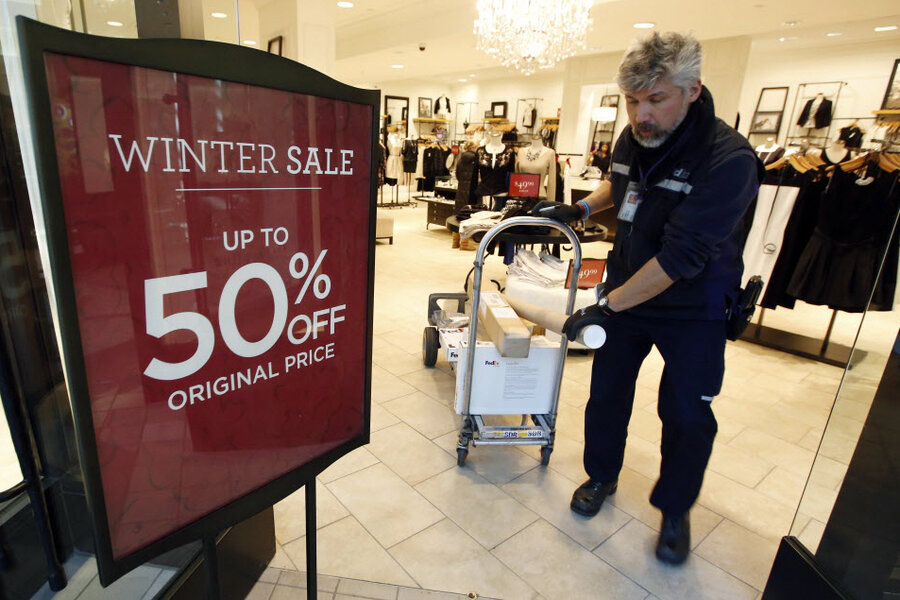Retail sales just ho-hum this holiday season
Loading...
As the U.S. holiday season winds down, retailers were left to hope that post-Christmas sales could help salvage their worst performance since 2008, preliminary data showed.
Holiday-related sales rose 0.7 percent from Oct. 28 through Dec. 24, compared with a 2 percent increase last year, according to data from MasterCard Advisors SpendingPulse.
The preliminary estimate from SpendingPulse was in line with other estimates showing weak growth during the holiday season, when retailers can book about 30 percent of annual sales and in many cases half of their profits.
On Tuesday, the International Council of Shopping Centers and Goldman Sachs Weekly Chain Store Sales Index said sales rose only 0.7 percent in the week ended Saturday.
And last week, research firm ShopperTrak lowered its holiday season forecast, calling for sales in November and December to increase only 2.5 percent from 2011, down from 3.3 percent.
The latest holiday season sales could be the worst performance since 2008, during the last recession, when sales dropped 4.4 percent in November and December.
"The broad brush was Christmas wasn't all that merry for retailers, and you have to ask what those margins look like if the top line didn't meet their expectations. So it could be a very unmerry Christmas for retailers," said Kim Forrest, senior equity research analyst at Fort Pitt Capital Group in Pittsburgh.
Analysts and industry groups expected sales to grow at a slower pace than in 2011 and 2010. The National Retail Federation predicted 4.l percent sales growth, versus a 5.6 percent increase a year earlier.
One bright spot has been online sales, which continue to grow at a faster pace. On Christmas Day, online sales jumped 22.4 percent, outpacing the 16.4 percent increase in 2011, according to IBM Digital Analytics Benchmark, which tracks more than 1 million e-commerce transactions a day from 500 U.S. retailers.
For the season, the Mid-Atlantic region showed the worst performance, with a 3.9 percent decline according to MasterCard SpendingPulse, as sales in early November were disrupted by Superstorm Sandy, which hit the densely populated area in late October.
"In general retailers were not necessarily expecting a huge season," said Michael McNamara, vice president of research and analysis at MasterCard SpendingPulse. "Inventory and management were tight really ever since 2008-2009."
'EXTRA CLEARANCE'
With the season a bit weaker than expected, especially in areas hit by Superstorm Sandy, "there could be some extra clearance this week and going into January," he said.
Investors were wary. The S&P 500 retail stock index declined nearly 1 percent on Wednesday morning, while the S&P 500 dipped 0.2 percent.
Some of the winning retailers were expected to be Wal-Mart Stores Inc, which attracted shoppers with early deals on the night of Thanksgiving and kept its focus on value, and apparel chains like Gap Inc, whose bright sweaters were successful, according to analysts.
Toys sold well across various chains, and hot items that were harder to find later in the season included certain Mattel Inc's Barbie dolls and LeapFrog Enterprises Inc's LeapPad2, according to B. Riley Caris analyst Linda Bolton Weiser.
The LeapPad2, an updated version of a 2011 bestselling tablet for kids, was on many top toy lists before the season began.
Sales recovered in the second part of November, with early hours and promotions helping drive traffic during the Black Friday weekend, analysts said.
But there was a deep lull in early December as a winter storm in parts of the United States may have limited sales, said McNamara.
The SpendingPulse data estimates sales of apparel, electronics, luxury goods, online and furnishings across all payment types, including credit cards, cash and checks, and not just the MasterCard payment network.
Aside from the weather, some analysts also said shoppers may have curbed spending due to concerns about whether Washington will reach an agreement to avert the "fiscal cliff" of tax hikes and spending cuts that take effect in the new year.
However, according to recent Ipsos polls for Reuters, roughly two-thirds of American adults said the fiscal cliff did not affect their holiday spending plans, and just 17 percent said they were spending less this year because of it.







